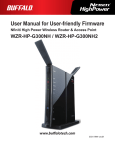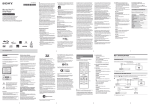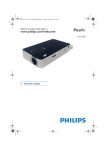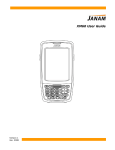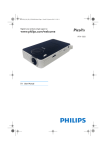Download Buffalo LPV4-U2-300S User manual
Transcript
Print Server LPV4-U2-300S User Manual www.buffalotech.com 35020240-03 2013-11 Contents Chapter 1 - Configuration..................................................5 Connecting with a Wired Connection..................................................5 Connecting to a Wireless Connection..................................................5 Select Wireless Access Point from Settings....................................................5 Connect Using WPS PIN Method.....................................................................7 Connect Using WPS Push-Button Method.....................................................8 Accessing Settings................................................................................9 Access Using IP Address................................................................................10 Access from Network-USB Navigator...........................................................11 Status...................................................................................................13 Device Status..................................................................................................13 System Status.................................................................................................14 Wireless Status...............................................................................................14 Network...............................................................................................15 General Settings............................................................................................15 TCP/IP..............................................................................................................16 Wireless LAN Settings (Easy Setup)..............................................................17 Wireless LAN Settings (Advanced Settings).................................................18 Wireless LAN Settings (WPS Settings)..........................................................19 Security................................................................................................20 Password Options..........................................................................................20 Maintenance........................................................................................21 Restart............................................................................................................21 Initialize..........................................................................................................21 2 Firmware Update...........................................................................................22 Default Configuration Settings..........................................................23 Chapter 2 - Network-USB Navigator...............................24 Introduction........................................................................................24 Install Network-USB Navigator..........................................................24 For Windows Users.........................................................................................24 For Mac Users.................................................................................................28 Confirm Settings............................................................................................31 Connect and Disconnect.....................................................................33 How to Connect to Printer.............................................................................33 How to Disconnect Printer............................................................................34 Send Disconnect Request...................................................................35 Main Window.......................................................................................37 Buttons...........................................................................................................37 Status..............................................................................................................38 Options................................................................................................38 How to Open Options....................................................................................38 Description.....................................................................................................39 Notes....................................................................................................41 Chapter 3 - Settings..........................................................42 Print Data from Your Mobile...............................................................42 Check Ink Level....................................................................................42 Use Scanning Function.......................................................................43 3 Change Print Server’s IP Address.......................................................43 Switch from Wired to Wireless Connection.......................................44 Switch from Wireless to Wired Connection.......................................44 Initializing the Print Server................................................................45 Press WPS Button...........................................................................................45 Configure in Settings.....................................................................................45 Chapter 4 - Troubleshooting............................................46 Cannot Print........................................................................................46 Cannot Access Print Server from PC..................................................47 Print Server Is Not Displayed on LPV4 Port Setup Wizard...............48 Print Server Is Not Displayed on Network-USB Navigator...............50 Cannot Find Access Point from Settings...........................................51 Cannot Connect Wirelessly Using WPS..............................................52 Forgot IP Address................................................................................53 How to Reconfigure the Printer Port.................................................55 For Windows Users.........................................................................................55 For Mac Users.................................................................................................58 Cannot Configure Printer Port with LPV4 Port Setup Wizard..........61 Appendix A - Supplemental Information.......................62 Technical Specifications.....................................................................62 FCC and IC Notice................................................................................63 4 Chapter 1 - Configuration Connecting with a Wired Connection The print server can be set up using a wired connection. Refer to the procedures below. The print server cannot use both a wired and a wireless connection at the same time. 1 Connect the print server to an access point using an Ethernet cable. 2 Connect the AC adapter to the print server. 3 After it powers on, check the side of the print server. Connecting to a Wireless Connection There are three ways to connect the print server to a wireless connection: selecting the wireless access point from print server’s Settings, WPS PIN method, or WPS push-button method. Refer to the procedures below. The print server cannot use both a wired and a wireless connection at the same time. WPA2-PSK (TKIP) encryption is also not supported. Select Wireless Access Point from Settings Once the print server is connected to a wired network, you can manually select the wireless access point to connect to from the print server’s Settings. To open Settings, refer to the “Accessing Settings” section below. Before starting, the print server’s connection method should be set to “Auto”. The access point should also have SSID broadcast enabled and is not using WPA2-PSK (TKIP) encryption. Refer to Chapter 4 for more information. 1 Set up the print server on a wired connection then log in to Settings. 2 Navigate to Network - Wireless LAN. 5 3 Select a wireless access point; enter the encryption key and click Apply. 4 After saving, the print server reboots automatically. 5 Disconnect the Ethernet cable from the print server. 6 Disconnect the AC adapter from the print server; wait about 10 seconds and reconnect it. 7 Check the LEDs on the side of the print server. Note: If the wireless LED is blinking, the connection could not be established. Check the access point and its encryption key and try again. 6 Connect Using WPS PIN Method You can use WPS to connect the print server wirelessly by registering the print server’s WPS PIN with your wireless access point. The print server’s WPS PIN can be obtained from Settings. To open Settings, refer to the “Accessing Settings” section below. Before starting, the print server’s connection method should be set to “Auto”. 1 Set up the print server on a wired connection then log in to Settings. 2 Navigate to Network - Wireless LAN - WPS Settings and click Execute WPS. 3 Within 2 minutes, register the displayed PIN with the target access point. 4 Confirm that “WPS Success” is displayed from Settings. If the following window is not displayed, the connection could not be established. Try again. 5 Disconnect the Ethernet cable from the print server. 6 Disconnect the AC adapter; wait about 10 seconds and reconnect it. 7 7 Wait about 30 seconds and check the LEDs on the side of the print server. Note: If the wireless LED is blinking, the connection could not be established. Check the access point and its encryption key and try again. Connect Using WPS Push-Button Method If your wireless access point has a WPS/AOSS button, you can use it to connect the print server wirelessly. Before starting, the print server’s connection method should be set to “Auto”. 1 Connect the AC adapter to the print server. If the print server was using a wired connection, disconnect both the Ethernet cable and the AC adapter from the print server and then re-connect the AC adapter only. 2 Wait for about 30 seconds, then press and hold the WPS button for about 5 seconds. 3 Press the access point’s WPS or AOSS button. Note: If you are using Buffalo router, press and hold the AOSS button for at least two seconds to start WPS. This may be different for other access point devices. 8 4 Wait about 30 seconds, then check the LEDs on the side of the print server. Note: If the wireless LED is blinking, the connection could not be established. Try again from step 3. Accessing Settings Configuration of the print server is done from Settings, the web-based configuration GUI. Note: Supported browsers include Internet Explorer 8 and later, Firefox 20 and later, and Safari 5 and later. 9 Access Using IP Address If you know the IP address of the print server on your network, just type it in to the URL field of your browser and press the enter key to open Settings. If you don’t know the print server’s IP address, refer to “Access from Network USB Navigator” below. 1 Open a web browser. 2 Enter the print server’s IP address in the address field and press the enter key. 3 When the security window appears, enter “admin” for the username and “password” for the password, then click OK. 10 Access from Network-USB Navigator If Network-USB Navigator has been installed on your PC, you can use it to open Settings. Note: Refer to chapter 2 to install Network-USB Navigator. 1 Open Network-USB Navigator. • For Windows 8, select Network-USB Navigator from the “Start” screen. • For Windows 7, Windows Vista, or Windows XP, navigate to Start - All Programs - BUFFALO - Network-USB - NetworkUSB Navigator. • For Mac OS, click the Network-USB Navigator icon in the dock. 2 Select your printer and click (properties). Note: If multiple USB devices are displayed, select the “LPV4-U2-300S”. 11 3 4 Click Device Server Properties. Settings will open. When the security window appears, enter “admin” for the username and “password” for the password, then click OK. 12 Status Device Status View information for the device connected to the print server. Status - Device Printer Name Queue Name Displays the name of the printer connected to the print server. Displays the queue name for LPR printing. 13 System Status View system information for the print server. Status - System IP Address Subnet Mask Default Gateway DHCP Server WINS Server Displays the assigned IP address. Displays the subnet mask. Displays the default gateway address. Displays the obtained DHCP server’s IP address. Displays the WINS server’s IP address. Wireless Status View wireless LAN interface information for the print server. Status - Wireless Displays the signal strength. Current SSID Current Channel Transfer Rate Displays the current SSID. Displays the current channel. Displays the wireless transmission rate. 14 Network General Settings Configure the hostname and the connection method here. Network - General Hostname Connection Method Enter a name for the print server. This will be displayed in Network-USB Navigator and other software. This name should be unique within your network. The hostname may contain up to 15 alphanumeric characters and hyphens (-). A hyphen cannot be used for the first character. After changing the hostname, the printer port must be reconfigured. Refer to Chapter 4 for more details. Select a connection method. Auto Detects the connection method automatically. If a LAN cable is attached to the print server, it uses a wired connection. Otherwise, the connection is wireless. Wireless The print server works as a wireless device. Wired The print server works as a wired device. 15 TCP/IP Configure print server’s network settings here. Network - TCP/IP Note: Only assign the print server a valid IP address, otherwise Settings cannot be accessed. If you cannot open Settings, initialize the print server, which restores all settings to their factory default values. DHCP IP Address Subnet Mask Default Gateway WINS Server If you’re using DHCP on your network, enable it here. If you don’t use DHCP, you’ll need to configure the print server’s IP address manually. If DHCP is not available on your network, you may configure the print server’s IP address manually here. If DHCP is not available on your network, you may configure the print server’s subnet mask manually here. If DHCP is not available on your network, you may configure the print server’s default gateway address here. If 0.0.0.0 is entered here, no default gateway is used. You may enter a WINS server address here (optional). If DHCP is in use, the WINS server assigned by DHCP will override this setting. 16 Wireless LAN Settings (Easy Setup) Configure wireless connection settings here. Network - Wireless LAN - Easy Setup Wireless Network List Encryption Key Apply Detected wireless devices are listed. Click Refresh List to search again. Up to 32 devices are displayed in order of strength of the signal. Enter the encryption key of the selected wireless device. Click this button to apply settings and reboot the print server. 17 Wireless LAN Settings (Advanced Settings) Configure advanced wireless settings here. Network - Wireless LAN - Advanced Settings SSID Network Authentication WEP Settings WEP Key Index Enter the SSID of the access point that you want to connect to. SSIDs may contain up to 32 alphanumeric characters, hyphens (-), and underscores (_). Select the same authentication method that your wireless router or access point uses. Open (No Authentication) Choose this if your network uses no authentication or WEP. WPA WPA uses PSK authentication, TKIP or AES encryption, and a pre-shared key. WPA2 WPA2 uses PSK, AES encryption, and a pre-shared key. Select whether to enable or disable WEP encryption. Select the number of the WEP key you want to use (1 - 4). This WEP key should be same as the one your access point is configured with. 18 WEP Key 1 WEP Key 2 WEP Key 3 WEP Key 4 WPA/WPA2 Settings Encryption Method Pre-shared Key Up to 4 WEP keys can be configured. Alphanumeric or hexadecimal WEP keys of either 64-bit or 128-bit lengths are supported. Select the encryption method for WPA authentication (TKIP or AES). This setting should match that of the access point. Note: Usually, AES is safer than TKIP. Always use AES for your wireless network if it is supported by your devices. Enter the pre-shared key. This is needed when TKIP or AES is used for encryption. Use the same key that your access point and other wireless devices are using. Use 8 - 63 alphanumeric or hexadecimal characters. Wireless LAN Settings (WPS Settings) Configure WPS here. Network - Wireless LAN - WPS Settings PIN Displays PIN for WPS connection. Click Generate PIN to generate new PIN. To connect to the access point, click Execute WPS and enter the PIN to the access point within 2 minutes. 19 Security Password Options Configure print server’s password here. Security - Password New Password Confirm The administrator password may contain up to 8 alphanumeric characters and underscores (_). This password is used for logging into Settings. Enter the password again for confirmation. 20 Maintenance Restart Restart the print server. Maintenance - Restart Restart Click Yes to restart the print server. All current connections to the print server will be disconnected. Initialize Initialize the print server. Maintenance - Initialize Initialize Click Yes to restore all settings to their factory default values. 21 Firmware Update Update the print server’s firmware. Maintenance - Firmware Update Note: Do not turn the power off until update is finished! When the power LED stops blinking and glows steadily, it is safe to turn off the power. Firmware File Click Browse and choose the firmware file. Click Update to start updating. 22 Default Configuration Settings Feature General Settings TCP/IP Settings Wireless LAN Settings Parameter Username Password Default Setting admin password LPV4-U2-XXXXXX (Where “XXXXXX” is the last 6 digits of the print server’s MAC address) Auto Enabled 0.0.0.0 0.0.0.0 0.0.0.0 0.0.0.0 None Open Off 1 None An 8-digit random value Hostname Connection Method DHCP IP Address Subnet Mask Default Gateway WINS Server SSID Network Authentication WEP Key Index WEP Key PIN 23 Chapter 2 - Network-USB Navigator Introduction Network-USB Navigator lets you connect a multifunctional printer and use functions such as scanning, ink levels, etc. You can also directly access Settings from the application. Note: While a printer is accessed through Network-USB Navigator, it cannot be used by anyone else. Disconnect the printer after using the application. Install Network-USB Navigator For Windows Users Follow the procedure below to install the application. 1 From a browser, go to “d.buffalo.jp/lpv4-u2-300s/” and download the LPV4-U2-300S utility. 2 Run the utility. 24 3 Click Network-USB Navigator. 4 If “User Account Control” is displayed, click Yes or Continue. 5 Read the user license agreement and click Yes to agree. 25 6 Click Next. 7 Click Start. 8 If “Would you like to install this device software?” is displayed, check Always trust software from “BUFFALO INC.”. and click Install. 26 9 Click Yes. 10Select Manual Connection and click Next. 11Click Finish. You have installed Network-USB Navigator. Next, go to “Confirm Settings”. 27 For Mac Users Follow the procedure below to install the application. Note: The examples in this chapter show OS X 10.8. Your operating system might be slightly different. 1 Access “d.buffalo.jp/lpv4-u2-300s/” and download the LPV4-U2-300S utility. 2 Run the utility and click Network-USB Navigator. 3 Click Continue. 4 Read the software license agreement and click Continue. 28 5 Click Agree to accept the software license agreement. 6 Click Install. 7 Enter your name and password, then click Install Software. 8 Click Continue Installation. 29 9 Click Restart. 10After rebooting, select Manual Connection and click OK. You have installed Network-USB Navigator. Next, go to “Confirm Settings”. 30 Confirm Settings Use the following procedure to make sure that Network-USB Navigator is configured correctly. Note: The examples here show Windows screens, but the procedure for Mac OS is the same. 1 Open Network-USB Navigator. • For Windows 8, select Network-USB Navigator from the Start screen. • For Windows 7, Windows Vista, or Windows XP, navigate to Start - All Programs - BUFFALO - Network-USB - NetworkUSB Navigator. • For Mac OS, click the Network-USB Navigator icon in the dock. 2 Select your printer and click (properties). Note: If multiple USB devices are displayed, select the LPV4-U2-300S. 31 3 Click the Connect tab, confirm that Enable Auto connect is not checked, and click Apply. Note: If Enable Auto connect is checked, uncheck it. 4 Click OK and close the application. You have finished confirming settings. 32 Connect and Disconnect Connect to or disconnect your printer with Network-USB Navigator. How to Connect to Printer 1 Open Network-USB Navigator. • For Windows 8, select Network-USB Navigator from the Start screen. • For Windows 7, Windows Vista, or Windows XP, navigate to Start - All Programs - BUFFALO - Network-USB - NetworkUSB Navigator. • For Mac OS, click the Network-USB Navigator icon in the dock. 2 Select your printer and click (connect). Note: • If multiple USB devices are displayed, select the LPV4-U2-300S. • If the printer driver installer is displayed, install the driver referring to the manual from your printer. 33 3 Confirm that You are connected is displayed. How to Disconnect Printer 1 Open Network-USB Navigator. • For Windows 8, select Network-USB Navigator from the Start screen. • For Windows 7, Windows Vista, or Windows XP, navigate to Start - All Programs - BUFFALO - Network-USB - NetworkUSB Navigator. • For Mac OS, click the Network-USB Navigator icon in the dock. 2 Select your printer and click (disconnect). Note: If multiple USB devices are displayed, select the LPV4-U2-300S. 34 3 Confirm that Available is displayed. Send Disconnect Request You can send a disconnection request to the user who is using the printer. 1 Open Network-USB Navigator. • For Windows 8, select Network-USB Navigator from the Start screen. • For Windows 7, Windows Vista, or Windows XP, navigate to Start - All Programs - BUFFALO - Network-USB - NetworkUSB Navigator. • For Mac OS, click the Network-USB Navigator icon in the dock. 2 Select your printer and click (disconnect request). Note: If multiple USB devices are displayed, select the LPV4-U2-300S. 35 3 4 The disconnect request is sent to the user who is using the printer. The window below appears on the desktop of the user who received the request. When the user clicks Yes, the printer will then be available for your use. 36 Main Window Buttons Refreshes the screen. Changes the view of the list. Opens options. Opens help menu. Displays the properties of the selected device. Sends disconnect request to the user who is using the selected device. Connects to the selected device. Disconnects the selected device. 37 Status Available You are connected In use You can use the printer. You are connected to the printer. Another user is connected to the printer or the printer is printing. Options How to Open Options 1 Open Network-USB Navigator. • For Windows 8, select Network-USB Navigator from the Start screen. • For Windows 7, Windows Vista, or Windows XP, navigate to Start - All Programs - BUFFALO - Network-USB - NetworkUSB Navigator. • For Mac OS, click the Network-USB Navigator icon in the dock. 2 Click 3 Options is displayed. (options). 38 Description General Launch Network-USB Navigator at Windows startup Don’t show Network-USB Navigator main window on program launch Show a balloon notification when an error occurs Show a confirmation message when disconnecting USB devices Automatically connect newly discovered USB devices. Check to launch Network-USB Navigator at Windows startup. Check to launch Network-USB Navigator minimized. Check to show a help balloon when Network-USB experiences a power surge or a USB device is not correctly disconnected. Check to show a disconnect confirmation prompt before disconnecting a USB device. A disconnect prompt is not shown when an application or the automatic printing feature initiates the disconnect. Check to automatically connect USB devices detected for the first time. 39 Search for Device Servers Enable broadcast addresses You do not need to enable for normal use. If your PC is connected to multiple networks, enter the broadcast address of the network which the print server is connected to. Display List Display Set the display order and which items to show and hide in the USB device list. Checked items will be shown. Use Up or Down to change the selection order. 40 Notes • Do not connect a USB hub to the print server. It may not work correctly. • Devices are not automatically reconnected when resuming from standby or hibernation. Use Network-USB Navigator to reconnect them. • Operation or configuration via Telnet is not supported. • Do not disconnect or eject USB devices while they are being accessed. • If your USB device doesn’t automatically connect after detection, connect the device manually. • If your USB device requires an AC adapter, be sure to connect it. • For the latest information and updates, go to our website. 41 Chapter 3 - Settings You can configure various settings of the print server. Print Data from Your Mobile You can use the ePrint app, available for iOS and Android, to print pictures or contact files directly from your mobile device. Refer to the following links for more information on ePrint. Overview and procedure: http://www.e-workshop-dev.com/PC_EN/eprint_e.html Support for ePrint: http://www.e-workshop-dev.com/PC_EN/inquiry_title_e.html ePrint for iPad, iPhone, and iPod touch: https://itunes.apple.com/en/app/eprint-free/id304220730?mt=8 ePrint for Android: https://play.google.com/store/apps/details?id=jp.co.microtech.android.eprint_free&hl=en Check Ink Level Follow the procedure below to check your printer’s ink level. 1 Open Network-USB Navigator and connect to your printer. 2 Use your printer’s included utilities to check the ink level. You may disconnect the printer afterwards. 42 Use Scanning Function Follow the procedure below to use the printer’s scanning function. The printer’s driver may be required. For more information, refer to your printer’s manual. 1 Open Network-USB Navigator and connect to your printer. 2 Use the printer’s scanning function. You may disconnect the printer afterwards. Change Print Server’s IP Address Follow the procedure below to change the print server’s IP address. 1 Open print server Settings and log in. 2 Navigate to Network - TCP/IP. 3 Disable DHCP and manually configure the IP address, subnet mask, and default gateway; click Apply when finished. 43 Refer to the example below (if network is on 192.168.11.0). DHCP - Disabled IP address - 192.168.11.222 Subnet mask - 255.255.255.0 Default gateway - 192.168.11.1 WINS server - 0.0.0.0 Note: Only assign the print server a valid IP address, otherwise Settings cannot be accessed. If you cannot open Settings, initialize the print server, which restores all settings to factory default. 4 When “Restart the print server to save the settings. Restart now?” is displayed, click OK. Switch from Wired to Wireless Connection The print server cannot use both a wired and a wireless connection at the same time. To switch from a wired connection to a wireless connection, refer to the Chapter 1 section “Connecting with a Wireless Connection”. Switch from Wireless to Wired Connection Follow the procedure below to switch wireless connection to wired connection. The print server cannot use both wired and wireless connection at the same time. Before starting, check that the connection method is ‘Auto’. 1 Disconnect the AC adapter from the print server. 2 Connect the print server to the router or hub with an Ethernet cable. 3 Connect the AC adapter to the print server. 4 Wait for about 30 seconds, then check the LEDs on the side of the print server. 44 Initializing the Print Server You can initialize the print server by holding down the WPS button, or from within Settings. Press WPS Button 1 2 Disconnect the AC adapter from the print server. Reconnect the AC adapter to the print server while holding down the WPS button. Hold down the WPS button until the power LED blinks green. Configure in Settings 1 Open print server Settings and log in. 2 Navigate to Maintenance - Initialize. 3 Click Yes. 4 When “Restore all settings to their factory default settings?” is displayed, click Yes. 45 Chapter 4 - Troubleshooting Cannot Print Case 1: Printer is not ready. Confirm that the printer’s power is on, and there is enough ink and paper. Case 2: Print server is not connected correctly. Check the LEDs on the side of the print server. If it is connected correctly, the LEDs will be lit as shown below. For wired connection: For wireless connection: Note: If the LAN LED is not lit while an Ethernet cable is connected, check the router and its connection. 46 Case 3: Connected to the printer using Network-USB Navigator. If the printer is connected to Network-USB Navigator, you cannot print. Disconnect the printer from Network-USB Navigator. Also, confirm that automatic connection is disabled. Case 4: Hostname has been changed. If you changed the print server’s hostname, you have to reconfigure the printer port. Refer to the “How to Reconfigure Printer Port” section. Cannot Access Print Server from PC Case 1: Print server is not connected correctly. Check the LEDs on the side of the print server. If it is connected correctly, the LEDs will be lit as shown below. For wired connection: For wireless connection: Note: If the LAN LED is not lit while an Ethernet cable is connected, check the router and its connection. 47 Case 2: The IP address is invalid. If print server was assigned an invalid IP address, Settings cannot be accessed. If you cannot open Settings, initialize the print server, which restores all settings to their factory default values. Print Server Is Not Displayed on LPV4 Port Setup Wizard Case 1: The IP address is invalid. If the print server was assigned an invalid IP address, Settings cannot be accessed. If you cannot open Settings, initialize the print server, which restores all settings to their factory default values. Case 2: Print server is not connected correctly. If it is connected correctly, the LEDs will be lit as shown below. For wired connection: For wireless connection: Note: If the LAN LED is not lit while an Ethernet cable is connected, check the router and its connection. 48 Case 3: Using a PC with multiple network interfaces. Open LPV4 Port Setup Wizard and navigate to Search for Print Server... - Configure.... Add the broadcast addresses of the network that the print server is connected to. 49 Print Server Is Not Displayed on Network-USB Navigator Case 1: The IP address is invalid. If print server was assigned an invalid IP address, Settings cannot be accessed. If you cannot open Settings, initialize the print server, which restores all settings to factory default. Case 2: Print server is not connected correctly. Check the LEDs on the side of the print server. If it is connected correctly, the LEDs will be lit as shown below. For wired connection: For wireless connection: Note: If the LAN LED is not lit while an Ethernet cable is connected, check the router and its connection. 50 Case 3: Using a PC with multiple network interfaces. Open Network-USB Navigator and options menu. Click Search for Device Servers tab and check Enable broadcast addresses, then add broadcast addresses of the network that the print server is connected to. Cannot Find Access Point from Settings Case 1: The access point is turned off. Confirm that the access point is turned on. Case 2: The access point has SSID broadcasting disabled. You will never find the access point if it disables broadcasting SSID. Navigate to Network - Wireless LAN - Advanced Settings and configure manually. Case 3: The access point sets the authentication method as WPA2-PSK (TKIP). WPA2-PSK (TKIP) is not supported. 51 Cannot Connect Wirelessly Using WPS Case 1: The access point is using WEP encryption. If the encryption method is set to WEP, you cannot use WPS to connect to the access point. Navigate to Network Wireless LAN - Advanced Settings and configure manually. Case 2: The access point has SSID broadcasting disabled. You will never find the access point if it disables broadcasting SSID. Navigate to Network - Wireless LAN - Advanced Settings and configure manually. Case 3: The access point is using WPA2-PSK (TKIP) authentication. WPA2-PSK (TKIP) is not supported. 52 Forgot IP Address You can check the print server’s IP address by using Network-USB Navigator. 1 Open Network-USB Navigator. • For Windows 8, select Network-USB Navigator from the Start screen. • For Windows 7, Windows Vista, or Windows XP, navigate to Start - All Programs - BUFFALO - Network-USB - NetworkUSB Navigator. • For Mac OS, click the Network-USB Navigator icon in the dock. 2 Select your printer and click (properties). Note: If multiple USB devices are displayed, select the LPV4-U2-300S. 53 3 The print server’s IP address is displayed in “IP Address”. 54 How to Reconfigure the Printer Port Follow the procedure below to reconfigure the printer port. The procedure is different between Windows and Mac OS. For Windows Users 1 Open the LPV4 Port Setup Wizard. For Windows 8, Select LPV4 Port Setup Wizard in “Start” screen. For Windows 7, Windows Vista, or Windows XP, Navigate to Start - All Programs - BUFFALO - LPV4 Print - LPV4 Port Setup Wizard. 2 Click Next. 3 Select Print with LPR (Line Printer Remote) and click Next. Note: Some printers may not support raw mode. 55 4 Click Search for Print Server.... 5 Select the print server and click OK. Note: If multiple print servers are displayed, confirm the MAC address or device name. 6 Click Next. 56 7 Click Next. Note: If “The printer port xxxxxxxxxxxxxxxxx already exists.” is displayed, cancel the configuration and refer to the “Cannot Configure Printer Port with LPV4 Port Setup Wizard” section. 8 Click Register. 9 Select the printer connected to the print server, then click Next. 57 10Click Register. Now the printer is ready to be used. For Mac Users 1 Navigate to System Preferences in Apple menu. 2 Click Print & Fax. 3 Click + and select Add Printer or Scanner.... Note: If the screen from step 4 appears when you click + , follow step 4. 58 4 Select the print server (its suffix is “-prm1”), then select Select Printer Software... from “Use”. Note: If your print server is not listed, confirm that it is connected correctly and try again. If you find multiple print servers, check your print server’s MAC address. 5 Select your printer and click OK. 59 6 Click Add. 7 Confirm that your printer is displayed. Now the printer is ready to be used. 60 Cannot Configure Printer Port with LPV4 Port Setup Wizard If the same port name is already registered, “The printer port xxxxxxxxxxxxxxxxx already exists.” may be displayed when registering the printer port. In this case, follow the procedure below to delete unnecessary printer ports. 1 Navigate to Control Panel - Devices and Printers, then open properties of your printer. 2 Click Ports tab. 3 Select an unnecessary port and click Delete Port. Note: The port which is currently used is displayed as “LPV4 Print LPR Port” in “Description” and checked. You can delete ports that are not checked. 61 Appendix A - Supplemental Information Technical Specifications Wireless LAN Interface Standard Compliance Transmission Method Frequency Range Transmission Rate Access Mode Security Wired LAN Interface Standard Compliance Transmission Rate Transmission Encoding Access Method Speed and Flow Control Other Specifications Printer Interface Power Supply Power Consumption Dimensions Weight Operating Environment Compatible OS Compatible Printers IEEE 802.11n / IEEE 802.11g / IEEE 802.11b Direct sequence spread spectrum (DSSS), OFDM, MIMO Available frequencies depend on the country of purchase. IEEE 802.11n: up to 300 Mbps IEEE 802.11g: up to 54 Mbps IEEE 802.11b: up to 11 Mbps Infrastructure Mode WPA2-PSK (AES), WPA-PSK (TKIP/AES), 64-bit or 128-bit WEP IEEE 802.3u (100BASE-TX) / IEEE 802.3 (10BASE-T) 10 Mbps or 100 Mbps 100BASE-TX 4B5B/MLT-3, 10BASE-T Manchester Coding CSMA/CD 10 Mbps or 100 Mbps, Auto Sensing, Auto MDIX 1 USB 2.0/1.1 port External AC 100-240 V Universal, 50/60 Hz About 2.3 W (Max) 72 x 127 x 25 mm (2.83 x 5 x 0.98 in.) 100 g (3.53 oz.) 0 - 40° C (32 - 104° F), 10 - 85% (non-condensing) TCP/IP (TCP#9100, LPR) Windows 8 (64-bit/32-bit), Windows 7 (64-bit/32-bit, SP1 or later), Windows Vista (64-bit/32-bit, SP2 or later), Windows XP (32-bit, SP3 or later), Mac OS (10.5, 10.6, 10.7, 10.8, Intel CPU only) Bonjour Mac OS (10.5, 10.6, 10.7, 10.8, Intel CPU only) USB 2.0 or 1.1 Printers Only 1 printer can connect to the print server at a time. Interactive communicationonly printers, WPS (Windows Printing System) printers, or GDI printers are not supported. 62 FCC and IC Notice FCC Part 15.19 This device complies with Part 15 of the FCC Rules. Operation is subject to the following two conditions: (1) this device may not cause harmful interference, and (2) this device must accept any interference received, including interference that may cause undesired operation. FCC Part.15.105(b) This equipment has been tested and found to comply with the limits for a Class B digital device, pursuant to Part 15 of the FCC Rules. These limits are designed to provide reasonable protection against harmful interference in a residential installation. This equipment generates, uses and can radiate radio frequency energy and, if not installed and used in accordance with the instructions, may cause harmful interference to radio communications. However, there is no guarantee that interference will not occur in a particular installation. If this equipment does cause harmful interference to radio or television reception, which can be determined by turning the equipment off and on, the user is encouraged to try to correct the interference by one or more of the following measures: -- Reorient or relocate the receiving antenna. -- Increase the separation between the equipment and receiver. -- Connect the equipment into an outlet on a circuit different from that to which the receiver is connected. -- Consult the dealer or an experienced radio/TV technician for help. FCC Part.15.21 You are cautioned that changes or modifications not expressly approved by the party responsible for compliance could void your authority to operate the equipment. 63 FCC RF Exposure Warning This device complies with FCC RF radiation exposure limits set forth for an uncontrolled environment. The antenna used for this transmitter must be installed to provide a separation distance of at least 20 cm from all persons and must not be co-located or operating in conjunction with any other antenna or transmitter. RSS102 2.6 Radiation Exposure Statement Déclaration d’exposition aux radiations This equipment complies with IC radiation exposure limits set forth for an uncontrolled environment. This equipment should be installed and operated with minimum distance 20 cm between the radiator and your body. Cet équipement est conforme aux limites d’exposition aux rayonnements IC établies pour un environnement non contrôlé. Cet équipement doit être installé et utilisé avec un minimum de 20 cm de distance entre la source de rayonnement et votre corps. Industry Canada statement Industrie Canada déclaration CAN ICES-3(B)/NMB-3(B) This device complies with RSS-210 of the Industry Canada Rules. Operation is subject to the following two conditions: (1) This device may not cause harmful interference, and (2) this device must accept any interference received, including interference that may cause undesired operation. Ce dispositif est conforme à la norme CNR-210 d’Industrie Canada applicable aux appareils radio exempts de licence. Son fonctionnement est sujet aux deux conditions suivantes: (1) le dispositif ne doit pas produire de brouillage préjudiciable, et (2) ce dispositif doit accepter tout brouillage reçu, y compris un brouillage susceptible de provoquer un fonctionnement indésirable. 64



































































